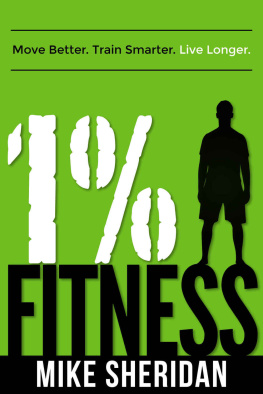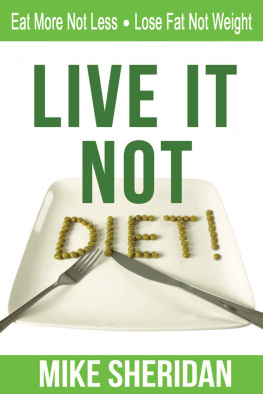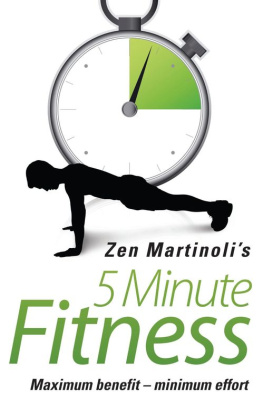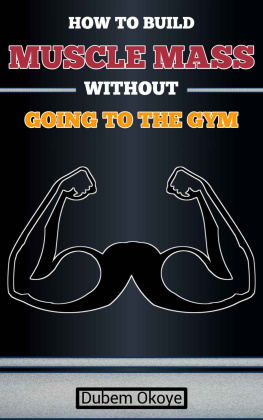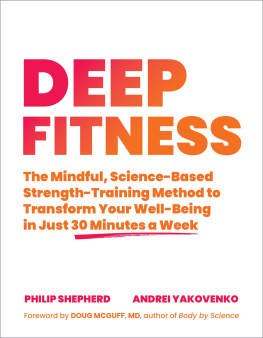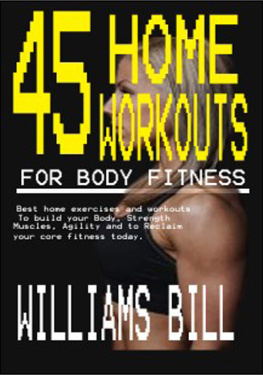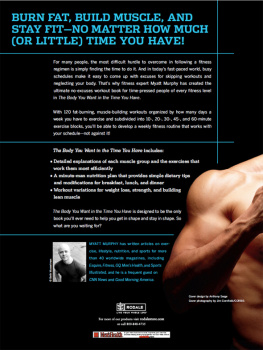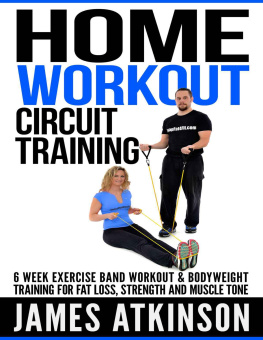1% FITNESS
Move Better. Train Smarter. Live Longer.
Mike Sheridan
Copyright 2015 Lean Living INC
All rights reserved. No part of this publication may be reproduced, distributed or transmitted in any form or by any means, including photocopying, recording, or other electronic or mechanical methods, without the prior written permission of the publisher, except in the case of brief quotations embodied in critical reviews and certain other noncommercial uses permitted by copyright law. For permission requests, email the address below with the subject line Copyright Permission.
1% Fitness/Mike Sheridan
ISBN: 978-0-9937455-7-7
contact@leanlivinginc.com
The ideas, concepts and opinions expressed in this book are intended to be used for educational purposes only. This book is sold with the understanding that author and publisher are not rendering medical advice of any kind, nor is this book intended to replace medical advice, nor to diagnose, prescribe or treat any disease, condition, illness or injury. It is imperative that before beginning any diet or exercise program, including any aspect of the training, nutrition, or lifestyle recommendations made in this book, you receive full medical clearance from a licensed physician. The author and publisher claim no responsibility to any person or entity for any liability, loss, or damage caused or alleged to be caused directly or indirectly as a result of the use, application or interpretation of the material in this book.
Contents
This book is dedicated to those that still believe they dont have time to exercise. Give me 1% of your week, and Ill give you the body youve always wanted.
The greater your muscle mass, the lower your risk of deathrather than worrying about weightwe should be trying to maximize and maintain muscle mass.
Dr. Arun Karlamangla
Introduction
Muscle & Health
If I asked you why you dont look and feel the way you want, youd probably answer:
I dont have the time.
or
I dont have the discipline.
I know this because conventional wisdom continues to give you a distorted image of what it takes to maintain an attractive physique. Like most North Americans, youve been led to believe that a better body is only achieved by eating like a bird and exercising like a maniac.
The common approach to getting fit is leaving 75% of the population Fat and Frustrated, and the other 25% Overworked and Underfed.
The reason you continue to fall short, or burn-out in an effort to keep up, is because more exercise and less eating is not the solution. As I outline in Eat Meat And Stop Jogging , our body adjusts to a chronic energy-shortage, by increasing hunger to access more calories, stockpiling fat as a fuel reserve, and slowing our resting metabolic (energy burning) rate.
Essentially, our body learns to function on less calories per day by using less energy, and storing more. Leading to weight regain shortly after the 3, 6, or 12 week restriction period, and leaving us with damaged hormones and a disrupted metabolism for up to a year afterwards! Meaning, despite efforts to eat less and exercise more in the future, we continue to fatten.
If you havent already, please check out Eat Meat And Stop Jogging before reading further (available on Amazon). This is the prerequisite to 1% Fitness, because its essential that you fully understand the nutrition and fitness misconceptions keeping North American fat and sick.
Conventional Wisdom = Under-Eat & Over-Exercise
For the last 50 years, weve been taught that improving our physique and maintaining our health requires:
- Restricting calories to lose weight
- Limiting animal protein to prevent degenerative disease
- Performing endurance exercise to burn calories
Meanwhile, all this caloric deficit and over-exercise plan does is elevate fat storage, accelerate muscle and bone loss, increase cortisol and oxidative stress, and lower immune function and reproductive health. Which, as discussed in Eat Meat And Stop Jogging , are all factors related to aging that we should be trying to avoid not promote.
Although many will achieve their goal of weight-loss by exercising more or eating less, research suggests that nearly 40% of that weight is muscle when lost via caloric reduction. Meaning 40% less of the tissue that raises our resting metabolic (energy burning) rate, and controls nearly 60-75% of our total energy expenditure.
A caloric-deficit (through diet or exercise) is a double-edged sword - as you continue to decrease the rate at which you burn calories, you lose useful muscle that would otherwise burn additional calories.
The less muscle you have, the less energy you burn, and the easier it is to gain. No matter how much you exercise, or how little you eat. The end result, is a high-fat low muscle physique, thats hardly aligned with why you started exercising and eating right in the first place.
One could argue that exercising to 'Burn Calories' is an even more damaging approach to getting fit as trying to eat less. Especially when that exercise choice is steady-state endurance training (cardio); which continues to be the universal choice. Largely, because weve developed the false belief that exercise should focus on burning calories, but also because weve been convinced that endurance training is best way to stay healthy and fit.
In reality, the only thing cardio promotes is the ability to run for a really long time. And aside from creating a physique thats far from ideal, this is an inferior biomarker for health and longevity.
- Muscle Mass
- Strength
- Metabolic Rate
- Body Fat Percentage
- Aerobic Capacity
Whats worse, is that cardio reduces the more critical biomarkers in the process. As those that continue to run, swim, and cycle further and more frequently in an effort to get and stay fit are losing muscle. And as it continues to decline, theyre losing strength, storing fat, and decreasing their resting metabolic rate.
Lower Muscle = Lower Health Span
With no plan to prevent it, we lose 40% of our muscle mass between the ages of 50 and 80.

Aside from declines in physical functioning and elevations in disability and mortality, this loss of lean muscle mass (sarcopenia) is a significant contributor to metabolic dysfunction. And regardless of body mass index, low muscle strength is predictive of mortality across all age groups over 50 (including the oldest of old 89+).

These reductions in insulin sensitivity, resting metabolic rate, and muscle protein synthesis, lead to elevated blood sugar, excess fat storage, and insulin resistance. Over time, this becomes diabetes, heart disease, cognitive impairment, and even cancer.
Basically, muscle loss and/or a lack of focus on preservation, is accelerating the aging process, and the unfortunate ailments that come with it. Whether from a physical strength and stability standpoint, or from a fat storage and metabolic disorder perspective.
Yet somehow we continue to prioritize exercise and follow diets that burn muscle? To please a scale that tells us nothing about our strength or muscle to fat percentage?
When we try to lose weight by depriving ourselves of essential nutrients, or chronically exercising to reach a deficit, we shorten our health span.
your lifespanhow many years you liveis important, but perhaps not as much so as your health span: that period of your life when youre functional and able to perform everyday life tasks for yourself. - Tufts University
Next page
